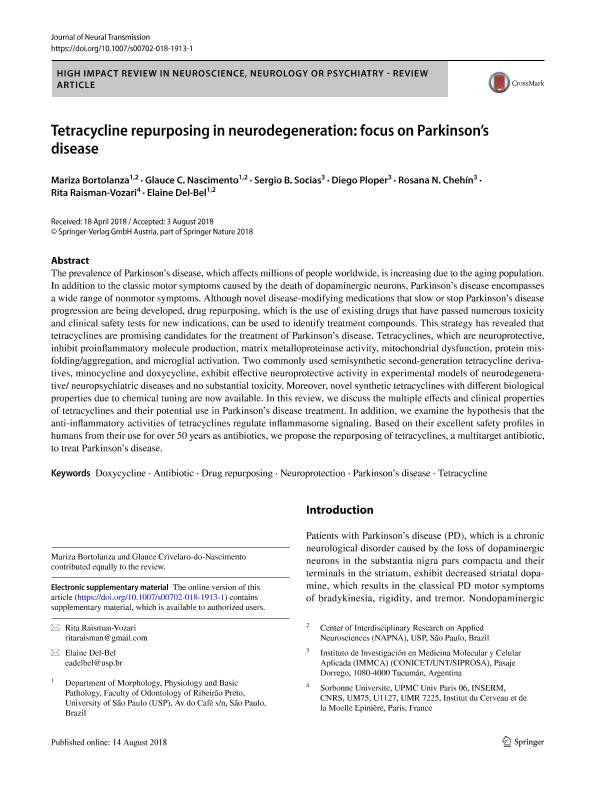Mostrar el registro sencillo del ítem
dc.contributor.author
Bortolanza, Mariza
dc.contributor.author
Nascimento, Glauce C.
dc.contributor.author
Socias, Sergio Benjamin

dc.contributor.author
Ploper, Diego

dc.contributor.author
Chehin, Rosana Nieves

dc.contributor.author
Raisman Vozari, Rita

dc.contributor.author
del Bel Belluz Guimaraes, Elaine

dc.date.available
2020-04-03T20:21:03Z
dc.date.issued
2018-08
dc.identifier.citation
Bortolanza, Mariza; Nascimento, Glauce C.; Socias, Sergio Benjamin; Ploper, Diego; Chehin, Rosana Nieves; et al.; Tetracycline repurposing in neurodegeneration: focus on Parkinson’s disease; Springer Wien; Journal of Neural Transmission. General Section; 125; 10; 8-2018; 1403-1415
dc.identifier.issn
0300-9564
dc.identifier.uri
http://hdl.handle.net/11336/101949
dc.description.abstract
The prevalence of Parkinson´s disease, which affects millions of people worldwide, is increasing due to the aging population. In addition to the classic motor symptoms caused by the death of dopaminergic neurons, Parkinson´s disease encompasses a wide range of nonmotor symptoms. Although novel disease-modifying medications that slow or stop Parkinson´s disease progression are being developed, drug repurposing, which is the use of existing drugs that have passed numerous toxicity and clinical safety tests for new indications, can be used to identify treatment compounds. This strategy has revealed that tetracyclines are promising candidates for the treatment of Parkinson´s disease. Tetracyclines, which are neuroprotective, inhibit proinflammatory molecule production, matrix metalloproteinase activity, mitochondrial dysfunction, protein misfolding/aggregation, and microglial activation. Two commonly used semisynthetic second-generation tetracycline derivatives, minocycline and doxycycline, exhibit effective neuroprotective activity in experimental models of neurodegenerative/ neuropsychiatric diseases and no substantial toxicity. Moreover, novel synthetic tetracyclines with different biological properties due to chemical tuning are now available. In this review, we discuss the multiple effects and clinical properties of tetracyclines and their potential use in Parkinson´s disease treatment. In addition, we examine the hypothesis that the anti-inflammatory activities of tetracyclines regulate inflammasome signaling. Based on their excellent safety profiles in humans from their use for over 50 years as antibiotics, we propose the repurposing of tetracyclines, a multitarget antibiotic, to treat Parkinson´s disease.
dc.format
application/pdf
dc.language.iso
eng
dc.publisher
Springer Wien

dc.rights
info:eu-repo/semantics/openAccess
dc.rights.uri
https://creativecommons.org/licenses/by-nc-sa/2.5/ar/
dc.subject
ANTIBIOTIC
dc.subject
NEURODEGENERATION
dc.subject
DOXYCYCLINE
dc.subject
DRUG REPURPOSING
dc.subject
NEUROPROTECTION
dc.subject
PARKINSON'S DISEASE
dc.subject
TETRACYCLINE
dc.subject.classification
Otras Ciencias Biológicas

dc.subject.classification
Ciencias Biológicas

dc.subject.classification
CIENCIAS NATURALES Y EXACTAS

dc.title
Tetracycline repurposing in neurodegeneration: focus on Parkinson’s disease
dc.type
info:eu-repo/semantics/article
dc.type
info:ar-repo/semantics/artículo
dc.type
info:eu-repo/semantics/publishedVersion
dc.date.updated
2019-10-16T19:28:49Z
dc.journal.volume
125
dc.journal.number
10
dc.journal.pagination
1403-1415
dc.journal.pais
Austria

dc.journal.ciudad
Viena
dc.description.fil
Fil: Bortolanza, Mariza. Universidade de Sao Paulo; Brasil
dc.description.fil
Fil: Nascimento, Glauce C.. Universidade de Sao Paulo; Brasil
dc.description.fil
Fil: Socias, Sergio Benjamin. Universidad Nacional de Tucuman. Instituto de Investigaciones En Medicina Molecular y Celular Aplicada del Bicentenario. - Gobierno de la Provincia de Tucuman. Ministerio de Salud. Sistema Provincial de Salud. Instituto de Investigaciones En Medicina Molecular y Celular Aplicada del Bicentenario. - Consejo Nacional de Investigaciones Cientificas y Tecnicas. Centro Cientifico Tecnologico Conicet Noa Sur. Instituto de Investigaciones En Medicina Molecular y Celular Aplicada del Bicentenario.; Argentina. Consejo Nacional de Investigaciones Científicas y Técnicas. Centro Científico Tecnológico Conicet - Tucumán; Argentina
dc.description.fil
Fil: Ploper, Diego. Consejo Nacional de Investigaciones Científicas y Técnicas. Centro Científico Tecnológico Conicet - Tucumán; Argentina. Universidad Nacional de Tucuman. Instituto de Investigaciones En Medicina Molecular y Celular Aplicada del Bicentenario. - Gobierno de la Provincia de Tucuman. Ministerio de Salud. Sistema Provincial de Salud. Instituto de Investigaciones En Medicina Molecular y Celular Aplicada del Bicentenario. - Consejo Nacional de Investigaciones Cientificas y Tecnicas. Centro Cientifico Tecnologico Conicet Noa Sur. Instituto de Investigaciones En Medicina Molecular y Celular Aplicada del Bicentenario.; Argentina
dc.description.fil
Fil: Chehin, Rosana Nieves. Universidad Nacional de Tucuman. Instituto de Investigaciones En Medicina Molecular y Celular Aplicada del Bicentenario. - Gobierno de la Provincia de Tucuman. Ministerio de Salud. Sistema Provincial de Salud. Instituto de Investigaciones En Medicina Molecular y Celular Aplicada del Bicentenario. - Consejo Nacional de Investigaciones Cientificas y Tecnicas. Centro Cientifico Tecnologico Conicet Noa Sur. Instituto de Investigaciones En Medicina Molecular y Celular Aplicada del Bicentenario.; Argentina. Consejo Nacional de Investigaciones Científicas y Técnicas. Centro Científico Tecnológico Conicet - Tucumán; Argentina
dc.description.fil
Fil: Raisman Vozari, Rita. Inserm; Francia. Sorbonne University; Francia
dc.description.fil
Fil: del Bel Belluz Guimaraes, Elaine. Universidade de Sao Paulo; Brasil
dc.journal.title
Journal of Neural Transmission. General Section

dc.relation.alternativeid
info:eu-repo/semantics/altIdentifier/doi/http://dx.doi.org/10.1007/s00702-018-1913-1
dc.relation.alternativeid
info:eu-repo/semantics/altIdentifier/url/https://link.springer.com/article/10.1007%2Fs00702-018-1913-1
Archivos asociados
